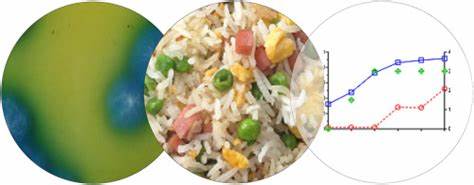- 1 November 2023
- 95
Avoiding Foodborne Illness: The Right Way to Store and Reheat Rice Dishes

Rice is a dietary staple enjoyed by people around the world. It’s versatile, filling, and delicious, but it also comes with some food safety concerns, particularly when it comes to storing and reheating rice dishes. In this comprehensive article, we will provide you with essential tips and guidelines for storing and reheating rice-based dishes safely. By understanding the importance of proper food handling, you can enjoy your rice dishes without the risk of foodborne illness.
The Risks of Rice: Understanding the Dangers
Rice, when not handled correctly, can be a breeding ground for bacteria, leading to foodborne illnesses. Let’s take a closer look at the risks:
- Bacterial Growth: Cooked rice is moist and starchy, creating an ideal environment for bacteria, such as Bacillus cereus, to thrive. This bacterium can produce toxins that are heat-resistant, surviving even the cooking process.
- Starchy Environment: The starchy nature of rice can lead to bacterial growth when combined with the right conditions. Bacteria, particularly Bacillus cereus, can multiply rapidly in moist and starchy environments, especially at room temperature.
- Spore Formation: Bacillus cereus can produce spores that are resistant to heat. These spores can survive cooking and, if rice is stored improperly, can germinate and produce toxins that can lead to food poisoning.
Image By: https://th.bing.com
Safe Practices for Storing Rice Dishes:
Proper storage is key to preventing bacterial contamination and ensuring the safety of your rice-based dishes. Here’s what you need to know:
- Prompt Refrigeration: As soon as your rice dish is cooked, it should be refrigerated within two hours to inhibit bacterial growth. The quicker it cools, the safer it becomes.
- Shallow Containers: Use shallow containers when storing rice dishes in the refrigerator. This helps the food cool down more rapidly and evenly, reducing the time it spends in the temperature danger zone where bacteria can multiply.
- Proper Refrigeration: Maintain your refrigerator at 40°F (4°C) or lower to inhibit bacterial growth.
- Prompt Consumption: For the best food safety, aim to consume your rice dishes within 1-2 days of initial cooking. If that’s not feasible, consider freezing them for later use.
Safe Practices for Reheating Rice Dishes:
Reheating rice dishes is just as important as proper storage. Follow these guidelines to ensure your rice dishes are reheated safely:
- Thorough Reheating: When reheating rice dishes, it’s essential to heat them to at least 165°F (74°C). This high temperature is crucial to eliminate potential bacteria or spores that may have developed.
- Use a Microwave or Stovetop: You can safely reheat rice dishes in either a microwave or on the stovetop. In both cases, make sure the dish reaches the recommended temperature.
- Microwave Technique: If using a microwave, distribute the dish evenly on a microwave-safe plate and cover it with a microwave-safe lid or plastic wrap, leaving a small vent for steam to escape.
- Stovetop Technique: When reheating on the stovetop, consider adding a small amount of water or broth to prevent the dish from drying out during reheating.
- Single Reheat: Avoid reheating rice dishes multiple times, as this increases the risk of bacterial contamination. Reheat only the portion you plan to consume.
Understanding Bacillus cereus and Toxin Formation:
Bacillus cereus is a bacterium that can contaminate rice dishes and produce toxins that lead to food poisoning. To minimize the risk, it’s crucial to follow these guidelines:
- Bacillus cereus spores: Bacillus cereus can produce spores that are resistant to cooking temperatures. These spores can survive the cooking process and, if rice dishes are stored incorrectly, germinate and produce toxins.
- Toxin Formation: The toxins produced by Bacillus cereus can cause food poisoning symptoms, including nausea, vomiting, diarrhea, and abdominal pain. Symptoms usually develop within a few hours after consuming contaminated rice dishes.
Image By: https://th.bing.com
Practical Steps for Food Safety:
In addition to proper storage and reheating, there are some practical steps you can take to enhance food safety when it comes to rice dishes:
- Hunger Awareness: Eat your reheated rice dishes promptly when you’re genuinely hungry. Avoid consuming dishes that have been sitting at room temperature for too long.
- Room Temperature: Do not leave cooked rice dishes at room temperature for extended periods, as this creates an environment conducive to bacterial growth.
- Refrigerate Cooked Rice Dishes: If you have excess cooked rice dishes, consider refrigerating them immediately rather than leaving them out. Refrigerated dishes can be used in various recipes.
- Meal Preparation: When preparing meals, make sure that rice dishes are thoroughly cooked. Proper cooking kills most harmful bacteria, ensuring that the dishes are safe to eat.
- Food Handling Hygiene: Practice good food handling hygiene by washing your hands, utensils, and surfaces before and after dealing with rice dishes.
- Food Journal: Keep a food journal or use a mobile app to track your meals and portion sizes. This can increase your awareness of your eating habits, including rice consumption.
Balancing Convenience and Safety:
While rice dishes can be convenient and delicious additions to your meals, it’s essential to balance that convenience with food safety. By following the guidelines provided in this article and understanding the potential risks associated with rice dishes, you can enjoy this versatile grain without compromising your health. With proper storage and temperature control, rice dishes can remain a delightful and safe component of your meals.



